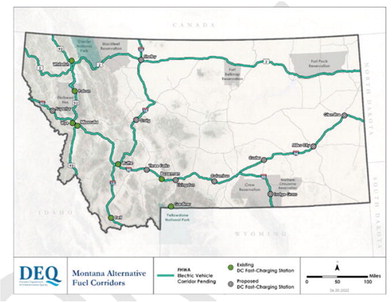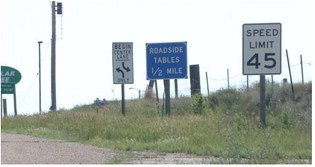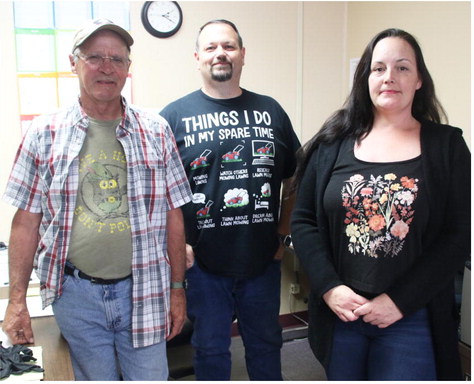DEQ Seeks Comment On Electric Vehicle Charging Station Plan


The Montana Department of Environmental Quality is seeking public input on a draft plan to build electric vehicle charging stations along “key travel corridors” in the state. Once finalized, the plan will detail how Montana intends to spend $43 million in federal funds earmarked for direct-current electric vehicle charging infrastructure that was included in the $1.2 trillion infrastructure package Congress passed last November.
The plan is intended to serve as a “backbone for future build-out of EV fastcharging stations” along interstates and key highways in Montana and support long-distance travel by Montana residents and visitors. It’s also intended to bolster economic development, tourism and workforce development, according to the draft document DEQ released June 27. The department estimates there will be 30,000 electric vehicle drivers in the state by 2030, along with 100,000 EV drivers from other areas traveling Montana roadways annually.
As of January, there were 1,893 fully electric vehicles and 1,002 plug-in hybrid vehicles registered in Montana. EV registrations have more than doubled since DEQ began collecting registration data in 2019, but Montana still has one of the lowest EV ownership rates in the country, with electric vehicles accounting for 0.18 percent of all light-duty vehicle registrations.
DEQ said the draft plan prioritizes areas where two travel corridors intersect as well “disadvantaged” and rural communities where private entities are less likely to invest in charging stations. National park gateway communities and “other recreation destinations” are also identified as priorities.
According to the draft plan, DEQ and the Montana Department of Transportation want to deploy fastcharging facilities no more than 50 miles apart that are located within one mile of established travel corridors and within walking distance of amenities in order to comply with requirements outlined in the National Electric Vehicle Infrastructure Program, which is part of President Joe Biden’s effort to curb greenhouse gas emissions.
DEQ also aims to design a system that’s capable of maintaining a “high operational reliability rate” — a nod to grid limitations expected to crop up in the form of overloaded substations or limited electricity supply during times of peak demand. The draft plan includes a list of 10 communities where such capacity issues are anticipated, six of which are located along US-2, the national highway that runs along northern Montana’s sparsely populated Hi-Line. Columbus, Superior, Darby and Dutton are also on that list.
The plan identifies the rough location of 131 existing charging stations in Montana along what the Federal Highway Administration calls alternative fuel corridors — routes that have been prioritized by the federal government for EV charging stations. Those routes include interstates 90, 15 and 94, and U.S. highways 93 and 2. About one-third of those existing stations were at least partially funded with money from Montana’s share of a 2017 settlement with the Environmental Protection Agency stemming from Volkswagen’s illegal circumvention of emissions monitoring technology.
Interstate 90 and U.S. Highway 93 are among the busiest roadways in the state. Both are located along the state’s Alternative Fuel Corridors, routes prioritized for EV charging stations by the Federal Highway Administration.
DEQ is accepting comments on the draft plan through July 18, ahead of an Aug. 1 deadline to forward the plan to the Federal Highway Administration. The department will host a virtual listening session with MDT on Monday, July 11.
DEQ collaborated with MDT on the draft plan, which was developed with input from tourism and economic development agencies, electricity utilities, EV charging station companies, small businesses, non-governmental organizations and business associations. DEQ included virtual and in-person meetings and public surveys in the effort, and invited members of the Legislature’s Transportation Interim Committee to comment on plan development. The agency received 388 responses to its survey.
The $43 million allocation will be distributed through the National Electric Vehicle Infrastructure Formula Program, which was established by the Bipartisan Infrastructure Law. It’s a five-year allocation, with the federal government slated to release between $6 million and $8 million annually, according to DEQ energy resource professional Kyla Maki.
Maki said DEQ will submit requests for proposals to begin building the charging stations after the Federal Highway Administration has approved the state’s plan, and will start scoring those proposals this coming winter or spring.



